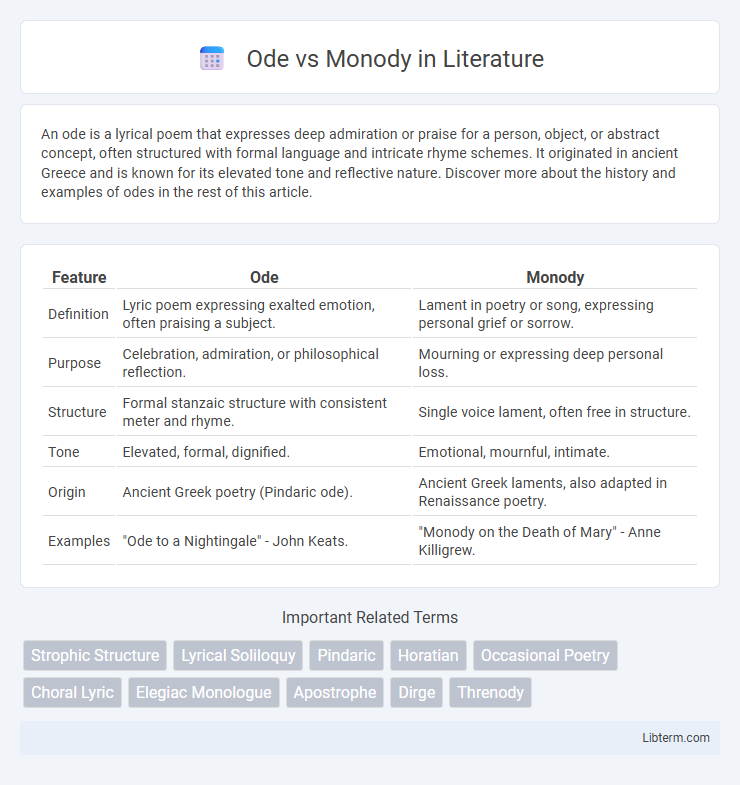An ode is a lyrical poem that expresses deep admiration or praise for a person, object, or abstract concept, often structured with formal language and intricate rhyme schemes. It originated in ancient Greece and is known for its elevated tone and reflective nature. Discover more about the history and examples of odes in the rest of this article.
Table of Comparison
| Feature | Ode | Monody |
|---|---|---|
| Definition | Lyric poem expressing exalted emotion, often praising a subject. | Lament in poetry or song, expressing personal grief or sorrow. |
| Purpose | Celebration, admiration, or philosophical reflection. | Mourning or expressing deep personal loss. |
| Structure | Formal stanzaic structure with consistent meter and rhyme. | Single voice lament, often free in structure. |
| Tone | Elevated, formal, dignified. | Emotional, mournful, intimate. |
| Origin | Ancient Greek poetry (Pindaric ode). | Ancient Greek laments, also adapted in Renaissance poetry. |
| Examples | "Ode to a Nightingale" - John Keats. | "Monody on the Death of Mary" - Anne Killigrew. |
Introduction to Ode and Monody
Ode and monody are both poetic forms that emphasize emotional expression and thematic depth. An ode typically features a formal, ceremonious style with varied stanzas praising people, nature, or abstract concepts, originating from ancient Greek lyric poetry. Monody, in contrast, is a solo lament or elegy, often expressing personal grief or sorrow through a single speaker's heartfelt narrative.
Defining Ode: Structure and Purpose
An ode is a lyrical poem characterized by its formal structure, often comprising three parts: the strophe, antistrophe, and epode, which together create a harmonious and balanced composition. Its purpose is to address and elevate a particular subject, person, or abstract concept with deep reverence and emotional intensity. Odes traditionally explore themes of praise, celebration, or reflection, employing rich imagery and elevated language to evoke admiration and contemplation.
Understanding Monody: Meaning and Origins
Monody is a form of solo vocal music accompanied by instrumental harmonies, originating in early 17th-century Italian Baroque music as a reaction against the complex polyphony of Renaissance madrigals. Its primary characteristic is a single melodic line expressing clear emotional narratives, emphasizing text clarity and dramatic expression. Understanding monody's function helps distinguish it from the more structured and often multi-voiced ode, highlighting its role in the evolution of opera and solo song genres.
Historical Context of Ode and Monody
The ode originated in ancient Greece as a formal, lyrical poem meant to be sung and accompanied by music, often celebrating gods, heroes, or significant events in classical society. Monody emerged during the early 17th century Italian Baroque period as a solo vocal style emphasizing expressive melody and emotional delivery, marking a shift from Renaissance polyphony to the beginnings of opera. This historical evolution highlights the ode's roots in communal celebration and monody's focus on individual emotional expression within the development of Western music and poetry.
Key Differences Between Ode and Monody
Odes are structured lyrical poems that celebrate or praise a person, event, or thing, often characterized by formal tone and elaborate style, while monodies are mournful or lamenting poems expressing solitary grief or sorrow. Odes typically employ varied stanza forms and longer length to convey admiration, whereas monodies use simpler, more direct language to emphasize personal lamentation. The key difference lies in their thematic focus: odes highlight exaltation and honor, monodies center on individual mourning and emotional expression.
Notable Examples of Odes in Literature
Odes are lyrical poems expressing exalted emotion, often dedicated to a person, object, or abstract idea, with notable examples including John Keats' "Ode to a Nightingale," Percy Bysshe Shelley's "Ode to the West Wind," and Pablo Neruda's "Ode to Salt." Monodies, contrastingly, are lamentations or dirges typically mourning a single death, as seen in John Milton's "Lycidas." The ode's structured stanzas and elevated tone distinguish it in classical and Romantic literature, highlighting themes of nature, beauty, and philosophy.
Famous Monodies and Their Impact
Monodies, characterized by solo vocal performances with instrumental accompaniment, have profoundly shaped Western music through iconic examples like Claudio Monteverdi's "Si ch'io vorrei morire" and Henry Purcell's "Dido's Lament." These monodies emphasized emotional expression and narrative clarity, influencing the early Baroque period and paving the way for opera and recitative styles. Their impact resonates in the evolution of dramatic music, highlighting personal intimacy and lyrical depth distinct from the more structured and communal nature of odes.
Stylistic Elements: Ode vs Monody
Odes feature elevated diction, structured stanzas, and formal tone, often celebrating or praising a subject with vivid imagery and elaborate metaphors. Monodies employ a more personal, melancholic tone with simpler, direct language, emphasizing emotional expression and lamentation through lyrical and repetitive patterns. While odes engage with grandeur and public display, monodies focus on intimate sorrow and private mourning.
Influence of Ode and Monody on Modern Poetry
Ode and monody significantly shaped modern poetry by introducing emotive depth and personal expression; the ode's lyrical praise expanded themes of admiration and idealism, while the monody's mournful lament influenced explorations of grief and introspection. Modern poets often draw on the ode's structured yet expressive form to evoke grandeur and reverence, whereas monody inspires poignant reflection and intimate narratives. These classical forms continue to enrich contemporary poetic techniques by blending traditional solemnity with innovative emotional resonance.
Choosing Between Ode and Monody in Creative Writing
Choosing between an ode and a monody in creative writing depends on the emotional depth and thematic focus desired; an ode typically celebrates a person, idea, or object with elevated language and structured stanzas, ideal for admiration and praise. A monody, in contrast, is a mournful, elegiac poem expressing grief or lamentation, often used to honor the memory of a lost individual. Writers should assess whether their work aims to inspire and exalt or to convey sorrow and remembrance to select the appropriate form.
Ode Infographic

 libterm.com
libterm.com